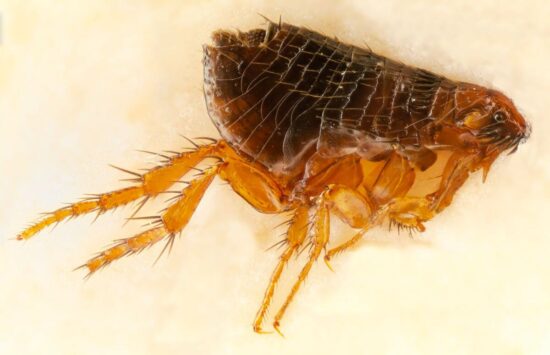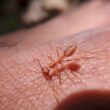Nobody wants to find a tiny jumping bug on their furry friend, but here’s the reality: if you find a flea on your dog, you’re likely dealing with more than just one little pest. These tiny creatures can breed within 24 hours and lay up to 50 eggs per day, which means that a single flea could quickly turn into a major problem.
Don’t worry though. While finding fleas on a dog can feel overwhelming, there are proven steps you can take right now to get the situation under control. The key is acting fast and being thorough. Most of the flea population actually lives in your home environment rather than on your pet, so you’ll need to treat both your dog and your house to win this battle.
The good news? With the right approach, you can eliminate fleas completely and keep them from coming back. Let’s walk through exactly what to do, step by step.
1. Don’t Panic but Check Everything Right Away
The moment you spot that first flea, take a deep breath. Panicking won’t help, but quick action will. Start by giving your dog a thorough inspection to understand what you’re dealing with.
Look for small black specks in your dog’s fur that look like pepper flakes. This “flea dirt” is actually flea droppings, and when you wet it, it turns reddish-brown because it contains digested blood. You can test this by putting some of the specks on a damp paper towel.
No products found.
Check the areas where fleas love to hang out: the base of the tail, neck, shoulder blades, and behind the ears. These warm spots are typical flea hangouts on dogs. Part your dog’s fur and look closely at the skin. You might see red bumps from flea bites or notice your dog scratching more than usual.
Use a fine-tooth flea comb if you have one. Run it through your dog’s coat and look for tiny dark bugs that jump away quickly. Even if you don’t see live fleas, finding flea dirt means they’re definitely there.
2. Give Your Dog a Flea Killing Bath Immediately
If you find a flea on your dog, one of the fastest ways to get relief is with a good bath. Warm water and mild soap can help get fleas off your pet’s skin and fur. You don’t need fancy products for this emergency bath, regular Dawn dish soap works great because it breaks down the fleas’ protective coating.
Start by wetting your dog’s neck area first and applying soap there. This prevents fleas from migrating up to the face when you put your dog in the water. Then wet the rest of your dog and work the soap into a good lather all over their body.
Let the soapy water sit on your dog for 5 to 10 minutes. This waiting time is important for killing fleas, and you can make it more comfortable for your dog by gently massaging their coat. The soap needs time to work its magic.
After the waiting period, rinse your dog thoroughly with warm water. You’ll probably see dead fleas washing away, which is exactly what you want. Make sure to get all the soap out of their fur to prevent skin irritation.
3. Use a Flea Comb to Remove Eggs and Leftover Bugs
Even after a bath, there’s more work to do. A flea comb is your secret weapon for getting the remaining eggs and any fleas that survived the bath. A flea comb can remove up to 60% of flea eggs on a dog, making it a crucial tool in your flea fighting arsenal.
Comb through your dog’s entire coat systematically, working in small sections. Pay extra attention to those problem areas where fleas like to hide. After every few strokes, dip the comb in a bowl of soapy water to drown any fleas or eggs you’ve captured.
If you see live fleas in the loose hair you comb out, simply pull the hair off the comb and seal it in a plastic bag. This prevents them from jumping back onto your dog or escaping into your house.
Plan to use the flea comb daily during an active infestation. It’s one of the most effective ways to physically remove fleas and disrupt their life cycle without using chemicals.
4. Call Your Vet for Professional Help
Here’s something many pet parents don’t realize: if you find a flea on your dog, the most important call you can make is to your veterinarian. Your veterinarian is very familiar with all the ways flea bites can present and can help determine if your pup might have fleas, rule out other skin conditions, and get flea protection on board as quickly as possible.
Your vet can prescribe the most effective flea treatments available. Over the counter products simply don’t work as well as prescription medications. Plus, your vet will make sure the treatment is safe for your specific dog based on their age, weight, and health condition.
Don’t wait to make this appointment. Some breeds like Collies, Australian Shepherds, and Shetland Sheepdogs have a gene mutation that makes it harder for them to break down certain medications, so professional guidance is especially important.
Your vet can also check for complications like flea allergy dermatitis or secondary skin infections that might need additional treatment. They’ll create a complete plan that addresses both immediate relief and long term prevention.
5. Start Prescription Flea Treatment Right Away
The most effective flea treatments require a prescription from your vet. These medications are much more powerful than anything you can buy at the pet store, and they target fleas at all stages of their life cycle.
Prescription flea and tick preventatives require a prescription from your veterinarian, and they typically cost a little more than over-the-counter options, but they’re much more effective. You have several options to choose from.
Topical treatments like Frontline Plus or Advantage II are applied to your dog’s skin once a month. They spread through your dog’s coat using natural skin oils and kill fleas on contact. These work well for dogs who don’t like taking pills.
Oral medications like NexGard or Bravecto come as chewable tablets. Most oral treatments need to be given every month, except Bravecto, which only needs to be given every 3 months. Many dogs think these taste like treats, making them easy to give.
Some combination products protect against fleas, ticks, and heartworms all in one treatment. Ask your vet which option makes the most sense for your dog’s lifestyle and your local pest pressure.
6. Clean Your Home Environment Completely
Most of the flea population lives in your home environment rather than on your pet, which means treating your house is just as important as treating your dog. If you find a flea on your dog, you can bet there are eggs and larvae hiding in your carpets, furniture, and anywhere your dog spends time.
No products found.
Start vacuuming everything: carpets, rugs, upholstered furniture, pet bedding, and even the cracks between floorboards. Vacuum at least every other day to control fleas, since flea eggs hatch within 2-3 days of being laid. Pay special attention to areas where your dog likes to rest or play.
After each cleaning session, place the vacuum bag in a sealed plastic bag and dispose of it outside. If you have a bagless vacuum, empty it right away and wash the container with hot soapy water. You don’t want those fleas escaping back into your house.
Vacuum every floor surface that your pets get on 3 to 4 times weekly for 3 to 6 weeks, including laminate, tiles, hardwood, carpets, and rugs. This might seem like a lot of work, but it’s essential for breaking the flea life cycle.
7. Wash Everything Your Dog Touches
Hot water is one of your best weapons against fleas. Use hot water to kill both fleas and their eggs on any fabric items your dog comes into contact with.
Start with your dog’s bedding, blankets, and any toys that can go in the washing machine. Wash all bedding and pet beds your pets are able to get on 3 to 4 times weekly for 3 to 6 weeks using hot water and normal detergent. The heat will kill fleas at every stage of their development.
Don’t forget about your own bedding if your dog sleeps on your bed. Wash curtains, throw pillows, and any other fabric items in rooms where your dog spends time. If your dog rides in your car, vacuum the seats and wash any removable fabric covers.
Use a hot dryer setting afterward, as this continues the heat treatment process. The combination of hot water washing and high heat drying is lethal to fleas and their eggs.
8. Consider Professional Carpet Cleaning
Sometimes regular vacuuming isn’t enough, especially if you’re dealing with a heavy infestation. Carpet cleaning methods that use steam or hot water extraction can reach the necessary temperatures to eradicate fleas and their eggs.
Professional carpet cleaning equipment can get much hotter than home machines and penetrate deeper into carpet fibers where flea eggs hide. The high temperatures kill fleas on contact and help remove the organic debris that flea larvae feed on.
While professional carpet cleaning can effectively kill fleas in your carpeting on contact, it doesn’t eliminate the entire infestation since fleas can hide in various places throughout your home. Use carpet cleaning as part of your overall strategy, not as a standalone solution.
Schedule professional cleaning after you’ve started treating your dog and doing initial vacuuming. This timing helps ensure you get maximum benefit from the investment.
9. Use Flea Sprays and Growth Regulators
For serious infestations, you might need to bring in chemical reinforcements. The most effective flea control products contain ingredients that are lethal to adult fleas and an insect growth regulator that halts development of flea eggs and larvae.
Look for carpet sprays that contain ingredients like methoprene or pyriproxyfen. These insect growth regulators prevent flea eggs from developing into adults, helping break the reproduction cycle. Some products target adult fleas while others focus on eggs and larvae.
People and pets should remain off treated surfaces until the spray has dried, which may take a few hours depending on carpet type and ventilation. Always read the label carefully and follow safety instructions exactly.
Apply these treatments to all carpeted areas, paying special attention to places where your dog rests. Even after treatment, expect to see some fleas for a few weeks, as these are often newly emerged adults that haven’t yet come into contact with the treatment.
10. Keep Checking and Repeating Treatments
Finding fleas on a dog is just the beginning of the process. It usually takes 3 to 8 weeks to end a flea infestation, with some cases requiring up to 5 months of consistent treatment. Don’t give up if you still see some fleas after starting treatment.
Continue your daily inspections with the flea comb. Look for signs that your treatments are working: fewer live fleas, less scratching from your dog, and reduced amounts of flea dirt. Keep a simple log of what you find each day to track your progress.
Continue vacuuming every other day for at least 3 to 8 weeks after starting treatment. The vibration from vacuuming actually helps by stimulating dormant flea pupae to emerge, where they’ll encounter your treatments and die.
If you find a flea on your dog several weeks into treatment, don’t panic. Some newly emerged fleas are normal during the first month or two. However, if numbers aren’t decreasing or if they start increasing again, you may need to adjust your strategy.
11. Know When to Call Professional Exterminators
Sometimes DIY treatments aren’t enough, and that’s okay. It’s usually best to call an exterminator as soon as you suspect a flea infestation, no matter how small it may seem, since fleas multiply quickly and can hide extremely well.
You should call a professional for flea removal when DIY methods fail to control the infestation or when fleas continue to return despite repeated treatments. If you’ve been fighting fleas for more than 6 weeks without significant improvement, it’s time to bring in the experts.
Professional exterminators have access to stronger treatments that aren’t available to consumers. They use products that target all life stages of fleas and provide follow-up visits to ensure the infestation is fully eradicated. They can also identify problem areas you might have missed.
The cost to hire a flea exterminator ranges from $75 to $400, with the average cost being $270. While this might seem expensive, it can actually save money in the long run by eliminating the need for repeated DIY treatments.
Tips For Preventing Future Flea Problems
Once you’ve won the battle against fleas, the last thing you want is to go through this again. The best defense against future flea problems is a good offense with year round prevention.
Veterinarians recommend flea and tick prevention regardless of how much time a dog spends outdoors. Even indoor dogs can get fleas from other pets, wildlife, or fleas that people accidentally bring inside on their clothes.
No products found.
Keep your dog on a monthly flea preventive medication year round. These products stop fleas from being able to complete their life cycle on your pet, preventing infestations before they start. Your vet can help you choose the right product for your dog’s needs and lifestyle.
Maintain regular grooming and inspection routines. Brush your dog weekly and do monthly checks with a flea comb. Early detection gives you a big advantage in preventing major infestations. If you find a flea on your dog during these routine checks, you’ll be able to act quickly before the problem gets out of hand.
Keep your home clean with regular vacuuming and washing of pet bedding. A clean environment is less attractive to fleas and makes it easier to spot problems early.
Final Thoughts
If you find a flea on your dog, remember that quick action is your best friend. While it might feel overwhelming at first, following these steps will help you eliminate the fleas and prevent them from coming back.
The most important things to remember are that you need to treat both your dog and your environment at the same time, and that successful flea control takes patience and persistence. Battling a flea infestation requires lots of time, energy, and attention to keep eggs from hatching and reinfesting your pup.
Work closely with your veterinarian to choose the most effective treatments for your situation. Don’t hesitate to call professional exterminators if your DIY efforts aren’t working after several weeks. With the right approach and enough persistence, you can get your home back to being comfortable and flea free for both you and your furry friend.
The key is not to get discouraged if you don’t see immediate results. Stick with your treatment plan, keep up with the cleaning routine, and stay vigilant. Before you know it, those pesky fleas will be nothing but a bad memory.


